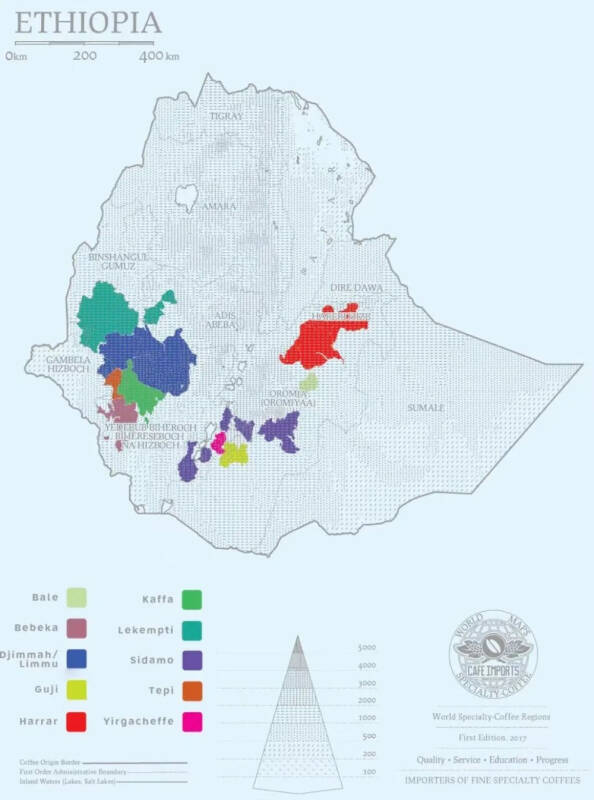Do you know how the Ethiopian drink coffee?

Ethiopia, as the country of origin of coffee, believes that it is a sacred place that countless friends think of day and night. Yejaschenne, Guji and Sidamo are all well-known coffee producing areas in Ethiopia, and their coffee flavors are very unique and well-loved by everyone.

So I wonder if you have ever understood how people in the places that produce these delicious coffees make coffee.
If you go to Addis Ababa, the capital of Ethiopia, there will be two very different cafes: one is influenced by the coffee culture brought about by the Italian occupation during World War II. Espresso-based cafes opened in prosperous urban areas In Ethiopia, there are more cafes of the second kind, which can be seen all over the streets of Egypt.
It is not so much a coffee shop as a coffee stand, because this kind of shop is very simple. Although it is easy, these coffee stalls sell the Ethiopian tradition, the coffee brewing method that the Ethiopian people have continued for thousands of years! The stall is filled with large and small cups and cans, including Jebena with African ceramic colors, and several earless ceramic cups, which are important instruments that make up the Ethiopian tradition. In addition to clay pots and earless cups, they will also be equipped with stoves, pans, and pestles and mortar, all of which are indispensable for coffee production.
When we drink coffee, we will pay attention to a freshness, which refers to brewing coffee beans during a period of time when the beans are roasted, so as to drink fresh coffee with excellent flavor! Ethiopian people also pay attention to freshness, but their freshness is not the same as ours, because Ethiopian freshness means to do it first. This "do" starts with fried coffee beans! First of all, the stall owner will add charcoal to the rectangular stove to light the fire, then put the pan on it, pour in the coffee beans and stir-fry. When the coffee beans are cooked, the stall owner will remove the pan, replace it with a clay pot filled with normal temperature water to heat it, and then pour all the coffee beans into a barrel-shaped pestle mortar to mash them. It takes about ten minutes from stir-frying to mashing.
After mashing, the water in the clay pot just boils and boils, and then the mashed coffee powder can be poured into the pot and the coffee can be boiled.
Until the hot water in the pot boils and boils again, which means that the production of coffee is finished! You need to be very careful when pouring out coffee, because if the range is too large, the coffee residue sunk at the bottom of the pot will be poured into the cup, resulting in the negative effect of one sip of coffee.
The whole process comes down, from the stir-frying of coffee beans to the production of coffee beans to coffee, I believe we can see that this way is relatively rough for us now. Ethiopia produces nearly 6.5 million bags of coffee beans every year, of which nearly 3 million bags are drunk by its own people! The remaining 3.5 million bags are all for export. From this data, we can see that the Ethiopian drink a lot of coffee!
Although drink too much, but the coffee-related technology is not superior! Because of the economic conditions and technical reasons of Ethiopia, these coffee beans are roasted and tested after being purchased and shipped abroad. Ethiopia has almost no baking conditions and technology related to fine coffee (rarely)! As a result, most of the finished coffee products that can be drunk in Ethiopia are relatively rough products!
And because of this, Ethiopia is now able to retain the tradition of thousands of years ago. In addition, in some of the older villages in Ethiopia, there are still ceremonies supporting the way of making coffee. Interested friends can move to Qianjie Coffee's "Ancient Coffee ceremony in Ethiopia" to learn more about this article. Even if this way of making coffee is not suitable for us now, Qianjie Coffee feels that it belongs to the unique charm of coffee culture in the old times. Isn't it a very romantic thing to feel the taste of coffee thousands of years ago in 2024?
-END-
Front Street Cafe
No. 10 Baoqian street, Yandun road, Dongshankou, Yuexiu district, Guangzhou, Guangdong province
Important Notice :
前街咖啡 FrontStreet Coffee has moved to new addredd:
FrontStreet Coffee Address: 315,Donghua East Road,GuangZhou
Tel:020 38364473
- Prev

Is the recently popular "butter coffee" good to drink?
Recently, the operation of adding butter to coffee has triggered another craze! Butter, also known as butter, cream, is a product obtained by separating cream and skim milk from milk, allowing cream to mature, stir, and add various operations. In the earliest days, butter's main use was in cooking.
- Next

Why is cold coffee always more expensive than American style? The difference between cold extract and ordinary American coffee
Black coffee means that there is no substance added to this cup of coffee that can affect the taste of coffee except water and coffee. Therefore, American style, hand brewing, cold extract, mocha pot coffee and so on all belong to black coffee with only water added. Then some careful students found that cold-extracted coffee is always higher than "coffee".
Related
- What ratio of water temperature and ground does the smart cup method use to press coffee? The difference between brewed coffee and filtered coffee?
- What is the standard process for the purpose of coffee cup testing? What is the difference between hand-brewed coffee and cup testing?
- How to use hand-brewed coffee paragon small golden balls? How does cold coffee lock in the aroma of coffee?
- Is American coffee black? What is the difference between American coffee and drip coffee?
- Unexpected! Well-known tea beverage brand Lele Tea will withdraw from the Zhengzhou market!
- Starbucks enters the fashion and beauty industry?! Netizen: Give me an ice American eye cream
- Why can American refills for free? The difference between Americano and American drip pot coffee
- Being chased out of the rain in front of Starbucks?! Store: Sheltering from rain under umbrellas poses a safety hazard
- The white moonlight has changed?! Lucky launches "Big Winter Pear American"
- Hand-brewed coffee three-stage method, high-sweet and universal brewing method to share! What does the high sweet water level of hand-brewed coffee mean?

